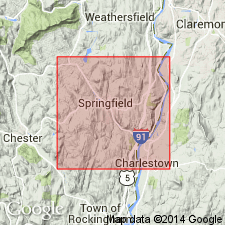
- Usage in publication:
-
- Brattleboro phyllite
- Modifications:
-
- Original reference
- Dominant lithology:
-
- Phyllite
- AAPG geologic province:
-
- New England province
Summary:
Pg. 232. Brattleboro phyllite. Includes all phyllites that flank Cavendish schist and Reading gneiss on east of Reading, Cavendish, Baltimore, and Chester. Its home is in Springfield, Rockingham, Putney, Brattleboro, Guilford, and Vernon, and southward into Massachusetts. Is youngest formation in southeast Vermont. Assigned to Ordovician. Named because Brattleboro Township [Windsor County, southeastern Vermont] is practically all covered with a fine-grained graphitic phyllite schist. Brattleboro phyllite and the older Randolph phyllite are interstratified with Waits River limestone.
Source: US geologic names lexicon (USGS Bull. 896, p. 254).

- Usage in publication:
-
- Brattleboro phyllite
- Modifications:
-
- Overview
- AAPG geologic province:
-
- New England province
Summary:
Pg. 192-211. Brattleboro phyllite may be time equivalent of Randolph phyllite. Belongs to Memphremagog group. Age is Ordovician.
Source: US geologic names lexicon (USGS Bull. 896, p. 254).
For more information, please contact Nancy Stamm, Geologic Names Committee Secretary.
Asterisk (*) indicates published by U.S. Geological Survey authors.
"No current usage" (†) implies that a name has been abandoned or has fallen into disuse. Former usage and, if known, replacement name given in parentheses ( ).
Slash (/) indicates name conflicts with nomenclatural guidelines (CSN, 1933; ACSN, 1961, 1970; NACSN, 1983, 2005, 2021). May be explained within brackets ([ ]).

